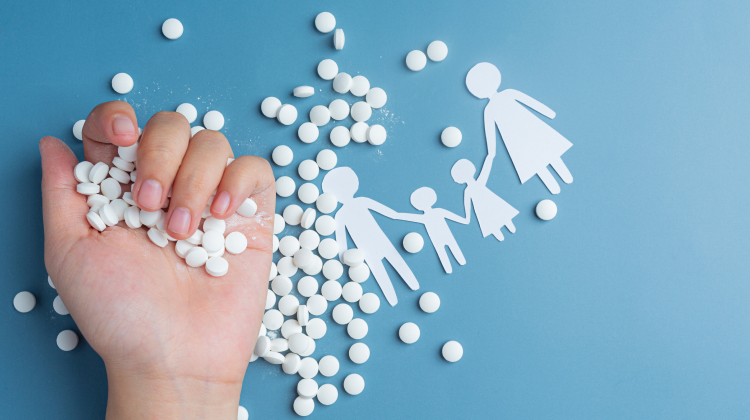Depression In Adolescence: What Is It, Causes, & How To Deal 2024

With the rates of youth depression and suicide growing, the need for increased awareness and availability of treatment is crucial.
Depression in adolescence statistics show that the prevalence of major depressive episodes rose from 8% to almost 16%[1] over the last decade. Girls have a particularly harder time, with an increase of 11% to 23% between 2009 and 2019.
Currently, it’s estimated that 34%[2] of youth aged 10 to 19 are at risk of developing clinical depression. These rates are even higher than those for 18 to 25, making the need for regular screening and available treatment essential.
Suicide rates are especially high among U.S. adolescents. Young adults committing suicide have increased by almost 30%[3] over the last decade, and at any moment, about 20% of teens are seriously thinking about suicide[4]. One of the main issues is unnoticed or untreated depression because inadequately treated depression is the major cause of suicide.
Read on to learn the signs, symptoms, and ways to help a teen with depression.
What Is Teen Depression?
Teen or adolescent depression[5] is a mood disorder that affects youth and can lead to other health issues or suicide. Intense feelings of hopelessness, sadness, anger, or frustration can last for weeks or more and interfere with normal daily functioning.
Like adult depression, teens diagnosed with major depressive disorder[6] require professional treatment. Unfortunately, depression often goes unrecognized in young people, making it all the more likely to reoccur later in life[7].
The long-term consequences of untreated teen depression[8] are:
- Antisocial behavior.
- Poor family relations.
- Impaired school performance.
- Recurrent depressive episodes.
- Other mental health conditions, such as anxiety disorders.
- Alcohol and substance abuse.
- Hospitalization.
- Suicide.
Immediate professional attention for mental health in teens is crucial as rates of suicide are highest in youth[4].
What Causes Depression In Teens?
Different social, family, and developmental challenges all cause high levels of stress and can lead to anxiety and depression. These are some of the most common risk factors for teen depression:
Emotionally Unavailable Parents
Many people are raised in families with emotionally unavailable and immature parents. The trauma of overly strict parenting, unrealistic expectations, and lack of validation or allowance for emotional expression is passed down through generations[9].
When empathy, understanding, validation, and full emotional expression are withheld from children, they’re more likely to develop mood and behavioral disorders[10] since their emotional development cannot progress. They don’t learn how to express themselves and often become overly self-critical, making mood disorders more likely when dissatisfaction with self makes for self-contempt.
Pessimistic parents can also train their children to develop the same patterns of thought. Fighting with children instead of holding a safe space for their emotions and encouraging open communication are some of the biggest risk factors leading to depression.
Traumatic Life Events
Experiencing traumatic or stressful life events affects both children and adults and creates a higher likelihood of developing mood disorders. This may include
- Parents divorcing.
- Death of a friend or relative.
- Breakup
- Violent household or difficult living situation.
- Emotionally or physically abusive parents.
- Sexual orientation unaccepted by family and/or friends (LGBTQIA+).
Continuing Maturation And Brain Development
Stress naturally occurs when maturing and managing the difficulties of bodily changes. Sex hormones fluctuate and can cause heightened emotions and hardships. The incidence of depression, for example, often increases after puberty, especially among girls. Also, this is an age during which the developing young brain undergoes reorganization[11], causing the occurrence of bad “executive” decisions which lead to stress.
The brain of an adolescent[12] is also different from adults, with neurotransmitters like dopamine, serotonin, and melatonin all influencing physical, cognitive, and socio-emotional development. Brain plasticity is also higher, which can lead to the development of specialized talents. Unfortunately, trauma, chronic stress, drug abuse, and sedentary lifestyles can negatively impact brain maturation and increase the risk of depression. Not all plasticity is good plasticity.
Genetics And Family History
Teens with parents who have depression are three to four times more likely to develop it as well, although studies with twins put more weight on psychosocial factors[13]. It’s likely a combination of genes and non-inherited factors, such as the emotional stress their parents may cause.
Chronic Illness
One-third of adolescents[14] in the U.S. live with a chronic illness. Like adults, the difficulties adjusting to the drawbacks of their condition often lead to mood issues like anxiety disorders and depression.
Chronic Stress And Other Mental Health Issues
Many teens with depression also have other mental disorders, such as ADHD, eating disorders, and anxiety or bipolar disorder.
Chronic stress[15], whether from a difficult living, school, or social situation, often leads to mental health problems. Financial difficulties, for example, take their toll on everyone, with teen depression highest in low and middle-income countries[7].
Psychological Adversity
There are numerous psychological ordeals that youth must face, which may include
- Racism.
- Sexual orientation prejudice (LGBTQIA+).
- Bullying.
- Social isolation (not “fitting in” or lack of social skills).
- Failure at school.
Teens who identify as LGBTQIA+[16] (lesbian, gay, bisexual, transgender, queer, intersex, asexual, and more) are at an especially high risk of severe depression. Stigma is still common in most of the world and when families are unaccepting and unsupportive, the risk only increases. Even if the teen is comfortable with their sexual identity, the way others respond to them highly affects their risk of depression.
Overall, teens who don’t have a strong support system and have trouble “fitting in” have the most difficulty. Close relationships and a community of support[17] are the most essential factors in reducing depression and improving overall mental health.
Symptoms
The Diagnostic and Statistical Manual of Mental Disorders states that MDD can be diagnosed in teens with two or more major depressive episodes for two weeks or more. The depressive episodes must include at least five of the following symptoms:
- Fatigue.
- Depressed mood.
- Difficulty concentrating.
- Unexpected weight changes.
- Loss of interest in activities.
- Agitation or psychomotor retardation.
- Changes in sleeping (over or undersleeping).
- Excessive guilt, shame, self-hatred, or worthlessness.
- Thoughts of death or suicide.
Subtle Signs Your Teen Has Depression
If you’re unsure as to what to look for, these are some everyday examples of teen depression:
- Frequently forgetting things, episodes of memory loss.
- Unusual defiance or acting out.
- Personality changes like more anger, crying, or irritability.
- Risk-taking behaviors.
- Decreasing school performance.
- Increasing isolation (avoiding friends or family).
- Criminal or violent behavior (shoplifting, getting in fights).
- Use of alcohol or illegal substances.
- Talking or joking about dying or life not being worth it.
It’s especially important to watch for signs or talk of suicide or death since rates of suicide are continuously increasing among youth. If you notice worsening symptoms or suicidal thoughts, call or chat online with the suicide and crisis lifeline at 988 or text HOME to 741741.
Dealing With Adolescent Depression
Paying attention to signs of depression and encouraging professional treatment can help teens with depression recover. The following are some of the steps that may help:
Screening

In 2018 the American Academy of Pediatrics[18] (AAP) established guidelines for universal screening of depression in youth 12 and over during their annual check-ups. After their primary care doctor performs their evaluation, any suspicions will lead to the teen being referred to a psychologist or psychiatrist for a psychological evaluation, covering their family history, social support, and school performance.
The medical check-up should also check for any medical conditions, hormonal imbalances, or nutritional deficiencies contributing to depression.
Unfortunately, primary care physicians fail to recognize depression in 30 to 50%[8] of patients, and it seems to be even more difficult for doctors to catch in teens. For this reason, friends, family, and those struggling should contact professional therapists and support groups[19] to ensure treatment is provided.
Therapy

The guidelines for care[18] in adolescent depression recommend cognitive behavioral therapy (CBT) and interpersonal psychotherapy, or IPT, as effective talk treatment plans. CBT[20] helps people improve their communication, problem-solving, and coping skills. They learn tools and methods to manage their thoughts and emotions more effectively.
IPT[21] focuses on the current crisis someone is facing. Specifically, it works to help the person increase their social support, decrease interpersonal stress and communication issues, and facilitate emotional processing. It’s solution-based and often more short-term and works well for depression, eating disorders, social anxiety disorder, and bipolar disorder.
Healthy Lifestyle Changes

There are many lifestyle and habit changes that can help to decrease depression, these include:
- Regular (and enjoyable) exercise (at least 150 minutes a week).
- Eating mostly nutrient-dense foods (adding vegetables to every meal and decreasing processed foods).
- Creative hobbies, activities, and outlets (dance, art, writing, photography, etc.).
- Regular time in nature (10-20 minutes per day or a few hours over the weekend).
- Participating in community activities (volunteer work, sports, or other teams, etc.).
Medication

Teens with depression are commonly prescribed SSRIs, or selective serotonin reuptake inhibitors. These antidepressant medications tend to have fewer side effects and work to improve serotonin function. There are particular SSRIs that have been approved for youth[22] with MDD, such as fluoxetine (Prozac) for age eight and up, and escitalopram (Lexapro) for age 12 and up.
However, these medications need to be closely monitored and should only be prescribed after a psychiatrist has done a proper evaluation and regular talk therapy continues. Potential risk factors that may increase the risk of self-harm and assessing other mental illnesses, such as attention-deficit/hyperactivity disorder (ADHD), substance misuse, family history, anxiety, and eating or bipolar disorder, must be considered.
Antidepressants have been shown to increase the risk of suicidal thinking and behavior[23] in young adults under 25. They can also trigger anxiety, restlessness, hostility, and impulsive behavior. The highest risk of suicide is often during the first few months of treating adolescent depression or when dosages are increased.
For this reason, it’s essential that medication is not the sole treatment plan for youth with depression. Families can contact support groups for their teens and find talk therapy options online or in person.
Prevention

A qualified mental health professional and social support are what people with depression need most. On top of talk therapy, precautions at home can be made, such as removing or securely locking and hiding:
- Alcohol.
- All prescription medications
- Firearms (guns and ammunition should be removed or locked and hidden separately).
With anxiety and depression on the rise, we can expect suicide to continue to increase as well, making prevention and precaution a necessity.
Suicide is the second-leading cause of death among youth[4], and signs of depression or suicide should never go ignored. If you notice worsening symptoms or suicidal thoughts, call or chat online with the suicide and crisis lifeline at 988 or text HOME to 741741.
The Takeaway
Whether adolescents suffer from depression or recover depends on a variety of factors. Reasons for developing depression vary from psychological adversity such as racism or sexual orientation prejudice to emotionally unavailable parents, traumatic experiences, and managing chronic or other mental health conditions. Sadly, many teens with depression go untreated, which contributes to extremely high suicide rates in youth.
Fortunately, with professional treatment, many teens are able to recover and avoid future reoccurrences. The earlier the signs are caught, and treatment begins, the better. A combination of talk therapy with family and social support offers the best chances of improvement. Also, for every child identified and treated, there may be younger siblings who can benefit from seeing his or her improvement.
+ 23 sources
Health Canal avoids using tertiary references. We have strict sourcing guidelines and rely on peer-reviewed studies, academic researches from medical associations and institutions. To ensure the accuracy of articles in Health Canal, you can read more about the editorial process here
- Daly, M. (2022). Prevalence of Depression Among Adolescents in the U.S. From 2009 to 2019: Analysis of Trends by Sex, Race/Ethnicity, and Income. Journal of Adolescent Health, [online] 70(3), pp.496–499. doi:10.1016/j.jadohealth.2021.08.026.
- Shorey, S., Ng, E.D. and Wong, C.H.J. (2021). Global prevalence of depression and elevated depressive symptoms among adolescents: A systematic review and meta‐analysis. British Journal of Clinical Psychology, [online] 61(2), pp.287–305. doi:10.1111/bjc.12333.
- Miron, O., Yu, K.-H., Wilf-Miron, R. and Kohane, I.S. (2019). Suicide Rates Among Adolescents and Young Adults in the United States, 2000-2017. JAMA, [online] 321(23), p.2362. doi:10.1001/jama.2019.5054.
- Nami.org. (2019). What You Need to Know About Youth Suicide | NAMI: National Alliance on Mental Illness. [online] Available at: https://www.nami.org/Your-Journey/Kids-Teens-and-Young-Adults/What-You-Need-to-Know-About-Youth-Suicide
- Medlineplus.gov. (2020). Teen Depression. [online] Available at: https://medlineplus.gov/teendepression.html
- Mayo Clinic. (2022). Depression (major depressive disorder) – Symptoms and causes. [online] Available at: https://www.mayoclinic.org/diseases-conditions/depression/symptoms-causes/syc-20356007
- Thapar, A., Collishaw, S., Pine, D.S. and Thapar, A.K. (2012). Depression in adolescence. The Lancet, [online] 379(9820), pp.1056–1067. doi:10.1016/s0140-6736(11)60871-4.
- Goyal, S., Srivastava, K. and Bansal, V. (2009). Study of prevalence of depression in adolescent students of a public school. Industrial Psychiatry Journal, [online] 18(1), p.43. doi:10.4103/0972-6748.57859.
- Grand, S. and Salberg, J. (2020). Trans-Generational Transmission of Trauma. Social Trauma – An Interdisciplinary Textbook, [online] pp.209–215. doi:10.1007/978-3-030-47817-9_22.
- Apa.org. (2022). APA PsycNet. [online] Available at: https://psycnet.apa.org/record/2001-00558-001?doi=1
- Sarah-Jayne Blakemore. (2018). The storm and stress in the adolescent brain. [online] Available at: https://www.thelancet.com/pdfs/journals/laneur/PIIS1474-4422(18)30112-1.pdf
- Sharma, S., Arain, Mathur, Rais, Nel, Sandhu, Haque and Johal (2013). Maturation of the adolescent brain. Neuropsychiatric Disease and Treatment, [online] p.449. doi:10.2147/ndt.s39776.
- Rice, F. (2010). Genetics of childhood and adolescent depression: insights into etiological heterogeneity and challenges for future genomic research. Genome Medicine, [online] 2(9), p.68. doi:10.1186/gm189.
- Zheng, K., Abraham, C., Bruzzese, J.-M. and Smaldone, A. (2020). Longitudinal Relationships Between Depression and Chronic Illness in Adolescents: An Integrative Review. Journal of Pediatric Health Care, [online] 34(4), pp.333–345. doi:10.1016/j.pedhc.2020.01.008.
- Sheth, C., McGlade, E. and Yurgelun-Todd, D. (2017). Chronic Stress in Adolescents and Its Neurobiological and Psychopathological Consequences: An RDoC Perspective. Chronic Stress, [online] 1, p.247054701771564. doi:10.1177/2470547017715645.
- Hall, W.J. (2017). Psychosocial Risk and Protective Factors for Depression Among Lesbian, Gay, Bisexual, and Queer Youth: A Systematic Review. Journal of Homosexuality, [online] 65(3), pp.263–316. doi:10.1080/00918369.2017.1317467.
- Reblin, M. and Uchino, B.N. (2008). Social and emotional support and its implication for health. Current Opinion in Psychiatry, [online] 21(2), pp.201–205. doi:10.1097/yco.0b013e3282f3ad89.
- Zuckerbrot, R.A., Cheung, A., Jensen, P.S., Stein, R.E.K., Laraque, D., Levitt, A., Birmaher, B., Campo, J., Clarke, G., Emslie, G., Kaufman, M., Kelleher, K.J., Kutcher, S., Malus, M., Sacks, D., Waslick, B. and Sarvet, B. (2018). Guidelines for Adolescent Depression in Primary Care (GLAD-PC): Part I. Practice Preparation, Identification, Assessment, and Initial Management. Pediatrics, [online] 141(3). doi:10.1542/peds.2017-4081.
- Mental Health America. (2022). Find Support Groups. [online] Available at: https://www.mhanational.org/find-support-groups
- What is Cognitive Behavioral Therapy (2017). What is Cognitive Behavioral Therapy? [online] https://www.apa.org. Available at: https://www.apa.org/ptsd-guideline/patients-and-families/cognitive-behavioral
- Lipsitz, J.D. and Markowitz, J.C. (2013). Mechanisms of change in interpersonal therapy (IPT). Clinical Psychology Review, [online] 33(8), pp.1134–1147. doi:10.1016/j.cpr.2013.09.002.
- Mayo Clinic. (2022). What to know about antidepressants for kids and teens. [online] Available at: https://www.mayoclinic.org/diseases-conditions/teen-depression/in-depth/antidepressants/art-20047502
- Center (2018). Suicidality in Children and Adolescents Being Treated With Antidepressant Medications | FDA. [online] U.S. Food and Drug Administration. Available at: https://www.fda.gov/drugs/postmarket-drug-safety-information-patients-and-providers/suicidality-children-and-adolescents-being-treated-antidepressant-medications



